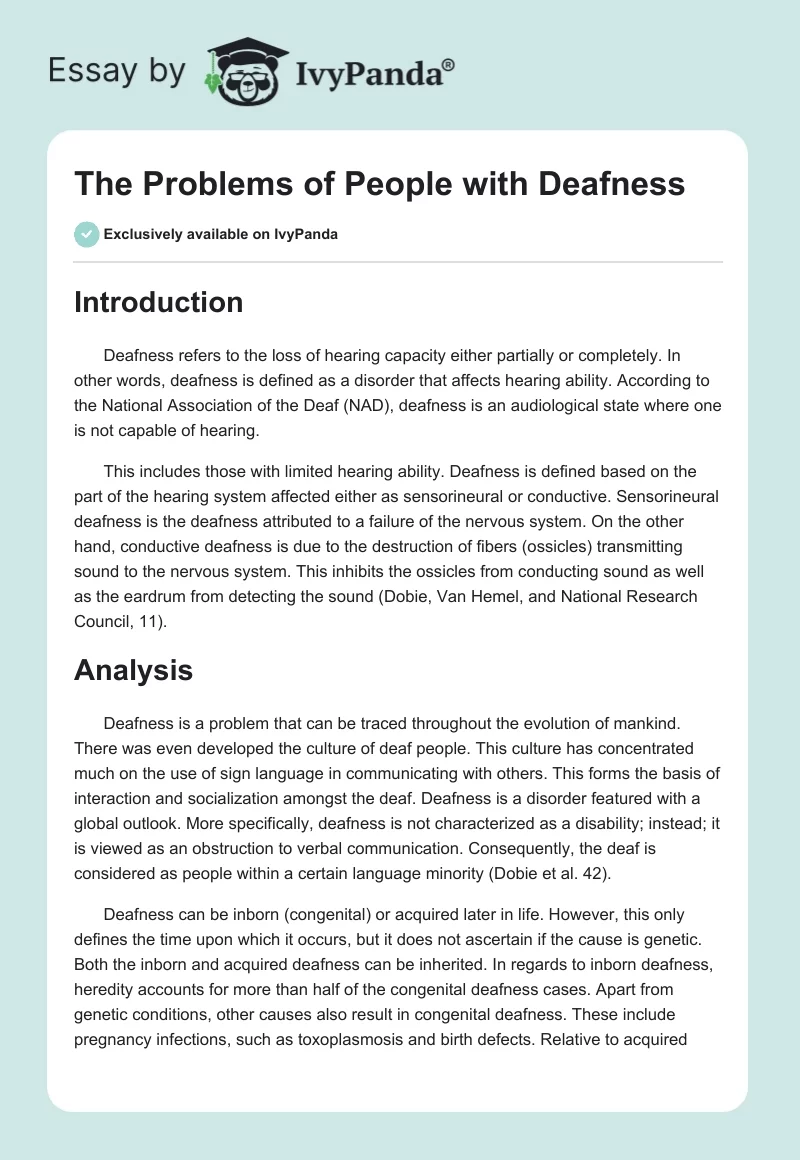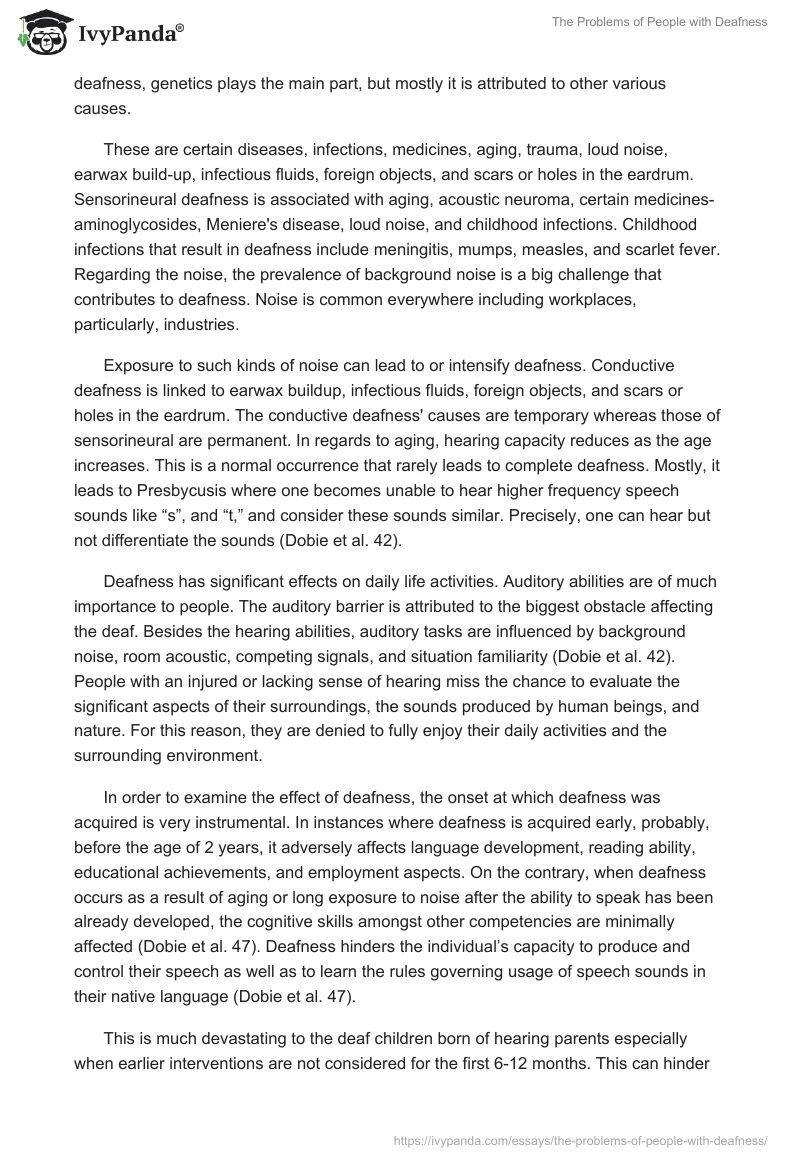Introduction
Deafness refers to the loss of hearing capacity either partially or completely. In other words, deafness is defined as a disorder that affects hearing ability. According to the National Association of the Deaf (NAD), deafness is an audiological state where one is not capable of hearing.
This includes those with limited hearing ability. Deafness is defined based on the part of the hearing system affected either as sensorineural or conductive. Sensorineural deafness is the deafness attributed to a failure of the nervous system. On the other hand, conductive deafness is due to the destruction of fibers (ossicles) transmitting sound to the nervous system. This inhibits the ossicles from conducting sound as well as the eardrum from detecting the sound (Dobie, Van Hemel, and National Research Council, 11).
Analysis
Deafness is a problem that can be traced throughout the evolution of mankind. There was even developed the culture of deaf people. This culture has concentrated much on the use of sign language in communicating with others. This forms the basis of interaction and socialization amongst the deaf. Deafness is a disorder featured with a global outlook. More specifically, deafness is not characterized as a disability; instead; it is viewed as an obstruction to verbal communication. Consequently, the deaf is considered as people within a certain language minority (Dobie et al. 42).
Deafness can be inborn (congenital) or acquired later in life. However, this only defines the time upon which it occurs, but it does not ascertain if the cause is genetic. Both the inborn and acquired deafness can be inherited. In regards to inborn deafness, heredity accounts for more than half of the congenital deafness cases. Apart from genetic conditions, other causes also result in congenital deafness. These include pregnancy infections, such as toxoplasmosis and birth defects. Relative to acquired deafness, genetics plays the main part, but mostly it is attributed to other various causes.
These are certain diseases, infections, medicines, aging, trauma, loud noise, earwax build-up, infectious fluids, foreign objects, and scars or holes in the eardrum. Sensorineural deafness is associated with aging, acoustic neuroma, certain medicines-aminoglycosides, Meniere’s disease, loud noise, and childhood infections. Childhood infections that result in deafness include meningitis, mumps, measles, and scarlet fever. Regarding the noise, the prevalence of background noise is a big challenge that contributes to deafness. Noise is common everywhere including workplaces, particularly, industries.
Exposure to such kinds of noise can lead to or intensify deafness. Conductive deafness is linked to earwax buildup, infectious fluids, foreign objects, and scars or holes in the eardrum. The conductive deafness’ causes are temporary whereas those of sensorineural are permanent. In regards to aging, hearing capacity reduces as the age increases. This is a normal occurrence that rarely leads to complete deafness. Mostly, it leads to Presbycusis where one becomes unable to hear higher frequency speech sounds like “s”, and “t,” and consider these sounds similar. Precisely, one can hear but not differentiate the sounds (Dobie et al. 42).
Deafness has significant effects on daily life activities. Auditory abilities are of much importance to people. The auditory barrier is attributed to the biggest obstacle affecting the deaf. Besides the hearing abilities, auditory tasks are influenced by background noise, room acoustic, competing signals, and situation familiarity (Dobie et al. 42). People with an injured or lacking sense of hearing miss the chance to evaluate the significant aspects of their surroundings, the sounds produced by human beings, and nature. For this reason, they are denied to fully enjoy their daily activities and the surrounding environment.
In order to examine the effect of deafness, the onset at which deafness was acquired is very instrumental. In instances where deafness is acquired early, probably, before the age of 2 years, it adversely affects language development, reading ability, educational achievements, and employment aspects. On the contrary, when deafness occurs as a result of aging or long exposure to noise after the ability to speak has been already developed, the cognitive skills amongst other competencies are minimally affected (Dobie et al. 47). Deafness hinders the individual’s capacity to produce and control their speech as well as to learn the rules governing usage of speech sounds in their native language (Dobie et al. 47).
This is much devastating to the deaf children born of hearing parents especially when earlier interventions are not considered for the first 6-12 months. This can hinder development in many aspects of education in communication and language use. In the education set up, communication is based on the degree of deafness; students with profound deafness are typically set for sings based programs whereas those with mild deafness take on speech-based programs (Dobie et al. 47).
As far as education and employment are concerned, communication access matters a lot more so for the deaf. When provided with equal education and employment chances, the deaf can do as much as the non-deaf can do. However, this equality is mainly dependent on access to necessary information for learning or performing the task. Communication access is based on the needs of individuals and the auxiliary ways to cater to these needs (Dobie et al. 47).
In most workplaces, communication access between workers is based on telephone use and video conferencing. This presents a big challenge among deaf workers. As described by Dobie et al. “the greatest challenge we face regarding communication access is neither technological nor legislative, but societal attitudes toward hearing loss – attitudes that seem to be shared fully by many people with hearing losses” (172). Therefore, a deaf worker will require enhanced communication access aids to enable them to communicate with others effectively. This has contributed to the deaf being discriminated against and losing their jobs in the workplace (Dobie et al. 165).
As earlier mentioned, their capacity is determined by the onset of their deafness. Relative to education, children with acquired deafness after learning, still perform well on the tests, as opposed to those with inborn or acquired deafness earlier. Unlike in education, deafness acquired after one has fully completed his/her education and has an already established career, deafness poses a problem in the performance and future mobility of the job. Most of the challenges are attributed to employer altitude towards the deaf. As described by NAD, an employer’s attitude plays a crucial role in enhancing these employment challenges. Many of the deaf are socially isolated and unsupported by their employers (Dobie et al. 165).
Conclusion
From a psychological perspective, deafness can lead to intensified distress levels. This is attributed to the fact that deafness disrupts communication as well as the perception of the surrounding sounds. This is common for those with acquired deafness as a result of aging and massive exposure to loud noise. Such individuals experience hardships in coping with this new state. Some are unwilling to accept and admit to this new state. This triggers frustrations and anger whenever they experience difficulties in communication which culminates to stress in the long run (Dobie et al. 165).
Works Cited
Dobie, Robert A., Susan Van Hemel, and National Research Council. Hearing Loss: Determining Eligibility for Social Security Benefits. Washington, DC: The National Academies Press, 2004. Print.


